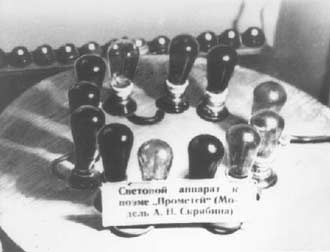 |
Fig. 1. Lighting instrument of A. N. Scriabin (~1911). |
The Ancient myth about Prometheus is widely known, and the idea of light-music synthesis in Scriabin's "Prometheus" gives rise to its own mythology as well. This process also concerns the lighting performances of "Prometheus". During the passed years many obscure points, relating this composition, have been clarified. The origins of Scriabin's ideas of arts synthesis are discussed in [1], the genesis and meaning of "Luce" - in [2, 3]. "Luce" is composed of two distinct layers: the "mobil" one, coloring harmonies, and the "slow" one, coloring the scheme of tonalities (in modern sense of the word "tonality"). The "slow" layer reflects the philosophic concept of the composition. The idea of "Luce" originates from the set of certain sight-hearing correspondences, having been formed in Scriabin's mind: "circle of fifths for tonalities - circle of colors" [4], and a special synesthesia, which makes his music so "light bearing" [5]. There are enough evidences that after the first rather timid effort in "Prometheus", Scriabin gradually overcame the defects of theosophic interpretation of "lighting symphony" as colored "aura" of music, and started to think over how to insert visual forms into "Luce" and to apply the method of sight-hearing counterpoint [6]. It's also known, that "Prometheus" more than once had been performed with lighting part since 1915, all around the world. The above ideas have been generalized in our special monography on Scriabin and his light-music heritage [7].
Nevertheless, both Russian and foreign art science is overflowed with speculations on esoteric inconceivable nature of "Luce" part, which makes it a subject of infinite decoding efforts; on the unique "colored hearing" of the composer. Beside that, new versions of Scriabin's color-tonality correspondences are being proposed [8, p.47]. As some extreme case, one could consider the following statement: "All attempts to perform "Prometheus" with lighting part have been as yet unsuccesful" [9, p.36]. Laying aside other topics of discussion (see about it [6, 10], let's dwell on the latter.
Since our Institute bears the name "Prometheus" [11], it is our duty to argue against the above statement. This made us to bring forward a short survey of "Prometheus"' performances with lighting, beginning from 1915 till now, in all the variety of interpretations and various artist's approaches. To write it we used data which are presented in more details in our former publications, and other home and foreign sources [especially see 7, pp.71-77, 114-125; 12, pp.128-139, 259-260; 13].
So, right after "Prometheus" had been composed, Scriabin began experiments using primitive light-music instrument (12 colored bulbs, fixed in a circle on the disc, the light being directed to the ceiling). It allowed to perform only single layer of "Luce", with no nuances at all (Fig. 1).
 |
Fig. 1. Lighting instrument of A. N. Scriabin (~1911). |
The rumour about the performance of "Luce" in Moscow Noble Assembly Hall has not been confirmed. This relates as well to the information on the analogous light-music concerts in Moscow, New-York and London in 1916 (although these are mentioned in a number of encyclopaedias) [12, p.259].
The first performance of "Luce" had occured at the last days of composer's life, on spring 1915, in New York Carnegie Hall. The light was projected onto multilayer screen, made of thin fabric. The performance aroused great hullabaloo [14] (Fig. 2).
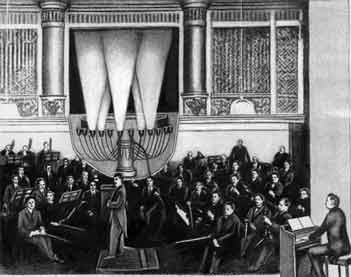 |
Fig. 2. The performance of "Luce" in 1915. |
The first performance in Russia had coincided with the February Revolution (the "Bolshoi" Theatre, Moscow, 1917). L. Sabaneyev played "Luce" part (which he knew as nobody else) with the standard light-music instrument (of those days). The poor quality of equipment and neglect of stage requirements had led to the regretful results (K. Balmont, E. Hunst, M. Mejchik).
It is unknown, whether "Luce" performance (announced in concert programme) actually took place in Philadelphia in the same year.
The first embodiment of "lighting symphony" in Soviet Russia was devoted to the anniversary of October Revolution (the "Bolshoi" Theatre, 1918). The projection of lights was combined with the scenery by A. Lentulov [15] (Fig.3).
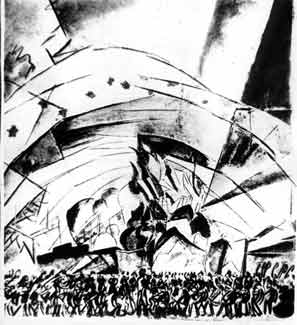 |
Fig. 3. The sketch of scenery for "Prometheus", by A. Lentulov (1918). |
The Russian artist G. Gidoni had constructed in 1925 original light-music instrument, and planned to perform "Luce", using interpretation by G. Rimsky-Korsakov (in which the flashes of light were added to pure still colors). This project was not realized. G. Gidoni proposed later to build the huge light-music hall for new Palace of Soviets, but he died in thirties at the time of terror [16].
In 1937, the famous English light-musician F. Bentham performed "Prometheus" with geometric images inserted into the lighting part.
During 30-s and 40-s of XX century, the only place in our country, still keeping up at least a dream of "Prometheus" performance with light, was the Museum of A. N. Scriabin. It's director T. G. Shaborkina and the composer's daughter M. A. Scriabina continued their work of popularization, scientific research, even constructing light-music equipment.
The first after World War II lighting concert took place in Kazan, April 1962, owing to combined efforts of students and teaching stuff of Aviation Institute and Conservatory. The producer A. Yusfin "mixed" both layers of "Luce" on a huge screen (180 sq.m. size) [17, p.15].
Two weeks later, the analogous concert had been conducted in Moscow Tchaikovsy Concert Hall, by the State Symphonic Orchestra (under the guidance of K. Ivanov). The lighting "Luce" part, in a quick monophonic version, was shown only at the Final, on velvet screen, hung up in front of the organ (engineer K. Lent'ev) [18].
In 1963-64, the "lighting symphony" was performed in Kazan, by means of new lighting instrument "Prometheus-2", able to create 120 shining points on the screen, each being a mixture of five different colors. Beside the insertion of "flashes", firstly proposed by G. Rimsky-Korsakov, a rather naive attempt had been made to separate spatially two layers of "Luce" (the "mobile" and "slow" layers being shown at different places on the screen) [17, p.149] (Fig. 4).
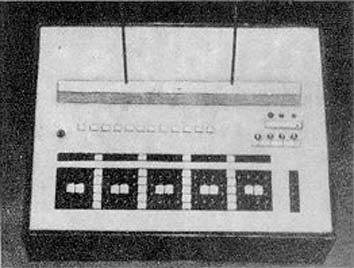 |
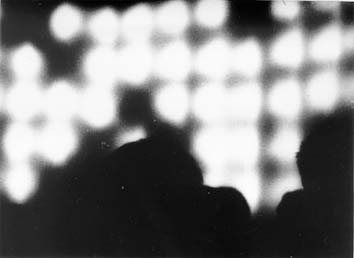 |
|
|
Fig. 4. "Prometheus" concerts in Kazan, 1963:
|
||
|
a) one out of the five control panels
|
b) the fragment of lighting concert
|
|
The experiments with figurative-lighting embodiment of "Luce" were going on in 1965-67, with the application of cinema technique. Several versions of experimental light-musical film "Prometheus" had been shot (producers B.Galeyev, I. Vanechkina). In the first version only pure colors were used, and both layers of "Luce" were mixed on the screen. Then we added certain spatial effects, such as lines, spots and shapes, reflecting themes of dramatic action (Fig. 5). Even black/white version had been made to demonstrate shape-to-color primacy inherent in light-music (compare it with melody-to-harmony primacy in the ordinary music) [7, p.233] (Fig. 5).
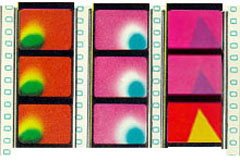 |
Fig. 5. Some shots out of the film "Prometheus". |
In 1970 the talented light-musician Yu. Pravdyuk presented original interpretation of "Prometheus" in his studio in Khar'kov. As Kazan's artists before, he used tape-recorded music. His complex multi-figured colorful composition, shown at 3 x 4 m screen, had proved to be very convincing, notwithstanding he did not strictly follow "Luce" (only in the main points).
The foreign performances of those years show large scale deviations from "Luce". Sometimes this occured just to mere misunderstanding of Scriabin's ideas. In 1967 "Prometheus" was performed with lighting in Rochester, USA by Philarmonic Orchestra under the guidance of L. Somogie (lighting part by A. Ushakov). They fully denied Scriabin's "Luce", pursuing the aim to stress with lighting the instrumentation instead of tonal scheme (as one could guess from newspaper publications).
In 1968 similar lighting concert had been performed in Stockholm Concert Hall, Sweden (conductor S. Herming). The merits of this premiere is obvious from the following newspaper's comment: "Since Scriabin pointed out in his score that "Prometheus" may be performed without lighting, it would be better (for the producer) to follow this advice".
In 1969-1972 a number of lighting concerts took place in USA, in the course of Scriabin's centenary celebrations. At the end of 1969, New-York Philarmonia Orchestra had shown "Prometheus" premiere in Lincoln Centre (conductor - S. Otzava, lighting part - P. Wexler). They presented their own interpretation of "Luce". The ceiling was being filled with colored stripes and at the Finale the psychodelic images were projected onto the screen. The conductor was being illuminated by stroboscopic flashes, similar to those used in dancing halls. The press characterized it as "electric circus".
The most successful and sensational "Prometheus" concert had been conducted, as many eye-withnesses say, in 1969 (repeated in 1971) in USA, by the Yale Symphonic Orchestra (conductor - D. Moserie). The lighting part was performed by F. Drurie (1969), and R. Gould (1971), the latter adhering Scriabin's color scheme. In addition to ordinary lighting effects, a number of others were used: lasers, vapours, even olfactory effects, far beyond the initial Scriabin's intentions (Fig. 6).
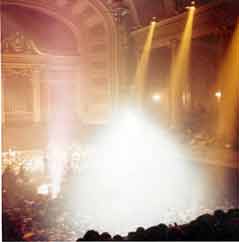 |
Fig. 6. "Prometheus" in New Heaven, 1971. |
In 1970 "Prometheus" had been performed in South Illinois University campus by the Saint Louis Symphonic Orchestra (conductor V. Saskind). Judging from press comments, they did not stick to "Luce".
One can guess the reaction of musicians to these pompouse shows by the following fact. After one of them some English reviewer wrote: "Praise God, this time "Prometheus" was performed without lighting". The concert in La Scala (Milan, 1970) is considered to be the most succesful effort among all the jubilee concerts abroad. It was guided by the prominent Czech scenographer J. Svoboda. He used powerful slide projectors in "fade-in" mode, and applied the combination of pure colors, envisaged by Scriabin, with abstract still images [19].
In England in post-war period the lighting symphony had been performed for the first time in 1972 (Albert Hall, London). The famous English musicologist H. McDonald added shining "stars" and "diamonds" to ordinary tints of pure colors. His next experiment in Oxford (1979) proved to be more exotic. The concert took place in the church, and in the absence of the screen the light was projected on to white clothes of choir singers.
In 1972 the Concert Hall "Oktyabrsky" in Leningrad received "Prometheus" performance, staged by V. Kataev and VA.Pavlov-Arbenin. Not only the screen was illuminated, but orchestra and the walls as well. The "Luce" part was completed by the "heaving" and "twinkling" light. With various modifications the concert was on stock during 1975-78 (producer - O. Averjanov, who took advices of Kazan's specialists) [20].
In 1973 Holland joined in the process of assimilation of Scriabin's heritage. In the concert in Scheveningen the original scenographic idea was applied - semitransparent balloon, illuminated from inside (designer W. York). Only quick monophonic layer of "Luce" was reproduced. Due to big size (7.5 m), the balloon seemed to fill the main body of rather small hall.
A sensational success fell on the concert in Iowa, USA (1975). Alas, there were no profound conceptions involved. The showmen used laser projectors to draw Lissajous figures on the screen. The background color was that of Scriabin's indeed, but the mad dance of Lissajous figures nullified any artistic effect (lighting part - L. Cross).
In 1975-80, "Prometheus" with lighting part was presented in the repertoire of Moscow cinema/concert hall "Russia" (conductor - K. Ivanov, engineer - K. Leontjev). The light projection was combined with cinema projection of moving images. The most broad audience and minimal artistic effect - this is the result of these concerts [21].
Now, let us remind, what we considered to be the right way to perform "Prometheus" (in our book dated by 1981): following Scriabin, the lighting part should be differentiated in two: "slow" layer as a background, and "mobil" one, which is developing over it and includes some structural elements. In case of more complicated interpretation, the deviations from "Luce" might be allowed in favour of more profound embodiment of philosophical program of the composition. Of course these deviations should be well motivated, originating from careful study, not from mere neglect of Scriabin's ideas. This conclusion had been made on the ground of our own experiments and other people's works during a period before 1980.
And the following concert practice has confirmed the validity and vitality of these proposals. Among the variety of new interpretations of "lighting symphony" there were true fundamental works, and mere sensational shows, exploiting concert technique - from ordinary theatrical lamps to lasers.
It must be added, that during eighties the scholars and practical performers got to know the "Prometheus" score copy, with Scriabin's own handwritten remarks relating to imaginative and plastical design of the composition. It was out of circulation for a long time, until it had been found again in Paris These "notes in the margins" reveal something which is absent in the original score. The color's names are present there too, yet they simply repeat that have been already known by the former studies of "Luce" structure and Scriabin's "color hearing" gift. Of course, a good number of performers never restricted themselves by pure color dynamics of "Luce", and introduced forms and moving light into action. Surprisingly, in many cases their ideas appeared to be in good correspondence with Scriabin's directions in the above score. It can be explained by the simple fact that both Scriabin and his later interpretators dealt with one and the same music ground. And now, having the score which is sanctified by the composer with his own hand, any talented producer has got an opportunity to use author's "hints" for more complex and fine arrangements of lighting substance (naturally, with the assistance of professional artists). Nevertheless, taking into account that any written instructions concerning form are too general and indistinct, the single canonical "strict to Scriabin" version hardly can be expected. At any rate, during the last 20 years the "Parisian" score of "Prometheus" more than once has been applied to lighting embodiment of "Poem of Fire".
In Florenz, 1980, the designer Bruno Menari illuminated during the performance the white objects in the interior of the stage by the powerful lighting projectors, to achieve the effect of "dematerialization".
At the same year, with no particular publicity or effect, the first in East Germany "Prometheus" performance went off in Berlin "Komische Oper".
In Leningrad, 1981, in the original TV version of "Luce" the picture of orchestra was being placed over color background, and some special TV effects were also applied (producer - D. Rozhdestvensky).
The most queer performance of "Prometheus" took place in Bochum, West Germany, 1981. A certain E. Kitzelbach has constructed "color piano" by a large number of neon tubes, arranged in a semicircle behind the orchestra. Such unexpected "electric sign" interpretation was motivated by the vanguard nature of Scriabin music. After a series of concerts the "color piano" had been handed to the city museum.
In 1983 the abovementioned H.McDonald had once again conducted "lighting symphony" in Leeds, UK. In order to achieve "waving" of colors, they were projected on to the whole forest of flattering cords. As a result, the light seemed as if dissolving in air. The concert of 1983 in Carnegie Hall, performed by the Baltimor Symphonic Orchestra (conductor S. Comission) and by the laser group of L. Cross, appeared to be a culmination of Cross' group tour around the USA, taking start in Iowa, by the show of dancing Lissague figures.
In 1986 one more lighting performance of "Prometheus" in USA has been realized by the National Symphonic Orchestra (conductor D. Maucherie), with color spots being projected synchronously with organ music.
In Antwerp, 1988, the producer G. Neyhold presented new realization of "Prometheus". The broad screen behind the orchestra was lit by the colored cross-rays, and "stars", "lightnings", "clouds" were being projected against that background (in accordance with Scriabin's notes in "Parisian" score) [22], (Fig. 7).
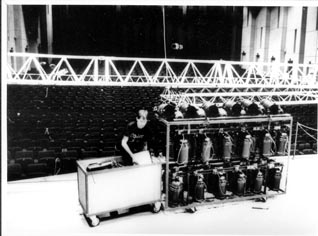 |
Fig. 7. Lighting equipment of the light-concert in Belgium, 1988. |
In USA, 1990, Philadelphia Orchestra (under the guidance of R. Mutie) performed "Poem of Fire" - again with the use of laser effects, "flickering on the screen above the orchestra".
In Germany, 1992, Berlin Philarmonia applied in "Prometheus" the batteries of lighting projectors, combined with smoke machines. According to press comments, "the mystics was replaced by the Hollywood effects".
In 1994 the Amsterdam group under remarkable name "Luce" (the head - H. Austbo) has carried out very interesting version of "Poem of Fire". The project was based on "Parisian" score and on the materials published by the Institute "Prometheus" in Kazan. The producer used separate screens to show constituent layers of "Luce" - the front one, constructed of five strips, total sizing 8 x 10 m, and the second one for background colors. The performers widely applied spatial dynamics of light. The staging process was then further elaborated in the course of next tours having been conducted in Bergen (Norgey), 1997 and several Holland cities, 1999. In fact, our Holland colleagues travelled the same way regarding assimilation of a new forms as our Kazan group did during 1962-1964, naturally on higher level. This effort is considered to be the most authentic embodiment of any Scriabin's ideas ever documented (Fig. 8). [23].
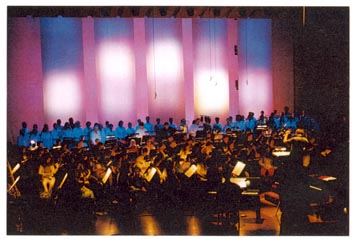 |
Fig. 8. Performance of "Luce" in Amsterdam. |
The more extravagant was next embodiement of "Prometheus" by another Holland group in 1998, which presented "Luce" show on TV. Although they used the same "Parisian" score of "Prometheus", the intensive and rather incoherent computer effects by the artist P. Strujken obviously dominated Scriabin's music. The scenography was impressive - the heads of chorus singers being popped through the holes in a huge screen...
In 1998 the conductor M. Pletnev and his Finnish colleague T. Alkhanen (lighting performer) presented canonical version of "Luce" in Bolshoi Concert Hall of Moscow Conservatory. Fast dynamics of "mobile" layer was displayed right on the organ tubes, and "slow" layer - on the frame of the stage and the walls. As usual, the producers put forward their priority pretensions (kind of "for the first time in the world"). The mass-media (including some music editions) published revelations such as that Scriabin had invented light-music long before discotheque era coming [24]. All that reflects the present situation around "lighting symphony".
The lighting concert in Kazan (1996) stands by itself. Bearing the title "Prometheus (Scriabin + Kandinsky)" it is an effort to fancy hypothetical creative alliance of the great composer and the great painter. Following thematic development and philosophical program of "Prometheus", the producers I.Vanechkina and B.Galeyev combined Scriabin's music with a sequence of Kandinsky's famous works, displaying them on the screen in fade-in mode. In 1999 this scheme was further elaborated - the authors added background dynamics of light (corresponding "slow" layer of "Luce") to the show of paintings. The performance is of regular run in Kazan studio of light-music until now (Fig. 9).
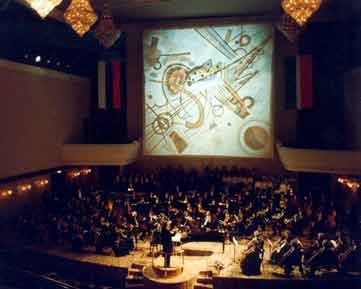 |
Fig.9 Preparing composition "Prometheus (Scriabin + Kandinsky)". |
The first performance of "lighting symphony" in Israel was realized in Tel-Aviv, 1999...
Obviously,our survey is not complete and some events might have been missed. Nevetheless we hope that the above examples demonstrate that it is right time to end "mythological" period of "Prometheus" history. Of course, light-music art includes more than one component, as well as theatre, cinema and TV arts do. No wonder that the success of any interpretation, be it canonical "Luce" version or the one with later Scriabin's additions, depends upon the producer's easy handling of the second component of synthesis - lighting material. It's high time now to give up searching the mystery of "Luce". The time has come to pass from the first naive experiment of "Prometheus" to practical assimilation of later Scriabin's ideas, assuming wide application of sight-hearing polyphony [17, pp.29-60]. Just these ideas had given him the rank of the true explorer of the future.
REFERENCES